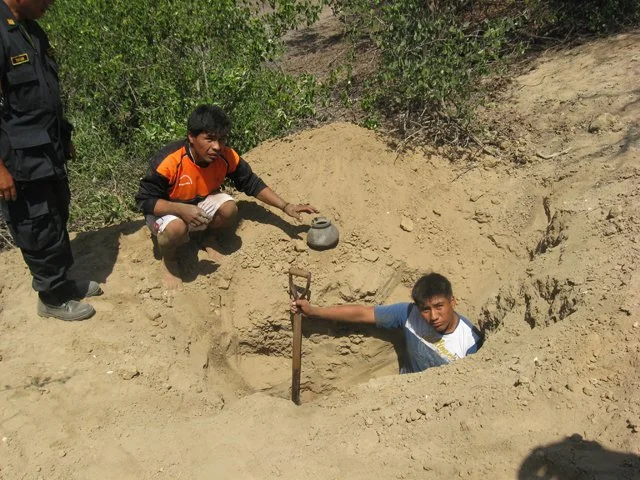Except for a tuft between their ears and on the end of their tail, these medium-sized, dark Peruvian dogs are completely hairless. In spite of their unorthodox looks - or perhaps because of them - viringo dogs were prized by the Moche, Chimu and Virus cultures, who included them as sacrifices in many important burials, and depicted them on painted pottery.
Kuelap Cable Car
The Kuelap cable car is one of the most important tourism projects in the country, which will offer an additional mode of access for visitors to the archaeological site. When completed, the four kilometre (2.5 mile) route, that goes from 2,000 m (6,562 ft) to 3,000 m (9,843 ft) above sea level, will be covered in 20 minutes.
Leymebamba Hiking
The attractive Amazonas town of Leymebamba is gradually becoming a trekking destination - perhaps to rival Cusco or Huaraz, one day - as the region's remarkable archaeology reveals more fascinating ruins, set in stunning mountainous and jungle-covered locations, replete with flora and fauna.
The wonderful trek to Condor Lake is already well-known, although far from busy; and below are a selection of six further hikes that can be done, beginning in Leymebamba.
Hiking to Kuelap
There is undoubtedly more than just a masochistic pleasure in hiking to a Peruvian archaeological site. Their awe-inspiring, natural settings can be savoured fully at walking pace; and the emotions unleashed by physical exertion seem to heighten an appreciation for the pre-Colombian, pre-wheeled-vehicle way of life.
In the case of Kuelap, to reach the ruins on foot, you will have had to ascend 1,200 m (3,940 ft) on a beautiful, but largely unshaded trail.
What to Bring on a Northern Peru Holiday
A good maxim when packing to go on holiday is 'half the luggage; twice the money'! Peru has plenty of shops, selling everything from Alpaca sweaters to camera batteries, and by spending in them, visitors are doing their bit to support the local economy.
Moreover, we once had a client arrive for a two-week holiday in Belize with just hand luggage ... and this was by choice, not at the whim of the airline. He had two shirts and would wash one, while he wore the other.
Nonetheless, Peru North understands that this is not the norm, and so please see our advice on what to bring. Northern Peru is a very diverse place, geographically, climatically and culturally, so there will be variations according to your exact destination. We will start with the essentials, and then suggest additions, according to the region or activity.
Peru's Tomb Raiders
Lares Trek - Alternative Route to Machu Picchu (or not)
I recently blogged about my 2015 trek on the Salkantay trail, which got me thinking about all my Peru hiking experiences. I've had the good fortune to have trekked most of the routes to Machu Picchu, including doing the Classic Inca Trail nine times, over the course of 16 years working and living in the country. However, now with a family and concomitant responsibility, the opportunities to head into the hills and disconnect for a few days, are few and far between.
I have to go back to August 2009 for the previous multi-day trek, Lares. Reassuringly, the photos reveal that I was using the same faded green hoodie then that I used for the Salkantay trek, six years later!
Salkantay Trek - Alternative Route to Machu Picchu
My first multi-day trek was on the Classic Inca Trail way back in 2000 while working as a Tour Leader … and I was immediately hooked. The scenery, the camaraderie, the archaeology and the sense of achievement upon arriving at the Sun Gate of Machu Picchu after four days’ hiking added up to a wonderful experience.
Now no longer a tour leader accompanying groups around Peru, the opportunity to go trekking in the spectacular Andes mountains have been much reduced. But, after years of longing, I finally completed the Salkantay Trek, one of the alternative routes to Machu Picchu, in July 2015.
Chachapoyas: Peru's most unexplored region?
Gocta Falls is the second highest waterfall in Peru, yet was not scientifically measured until 2006, at which time they were declared the third highest in the world (an opinion since revised several times). They are barely 32 km (20 miles) north of Chachapoyas as the crow (or condor!) flies, and yet had escaped the attention of travellers and researchers.
Ten years later, just how remote and unexplored is Chachapoyas?
Tucume Museum Recognised as a Best World Tourism Project
Tucume Museum, in the Department of Lambayeque on Peru's northern coast, was recognized by the British Travel Writers Guild (BTWG), as one of 2015's Best World Tourism Projects at the World Travel Mart in London.
Cajamarca: where History was Made ... and Ignored
The Cuarto del Rescate is one room, of Inca stonework, with a red line drawn at around 2m high, supposedly indicating the height at which the room was to be filled with gold treasures.
Not really much to indicate the change of regimes, religions, language and world view that the execution of Atahualpa signified. Not to mention the massive loss of life through pestilence and warfare.
Luckily, Cajamarca has a lot else to offer, even if its remarkable place in history is not abundantly obvious or celebrated.
Riding with Elvis ... to Three Forests
Peru is well known for its diversity, with the much-quoted triumvirate of Coast (Pacific), Mountains (Andes) and Jungle (Amazon) only providing a hint at the number of distinct eco-systems within her borders. To get an intense feel for this diversity, Peru North can recommend making the drive from Tarapoto in the department of San Martin, to Chiclayo in Lambayeque, on Peru's northern coast. And who better to have at the wheel for a journey as intensely spectacular as this, in the company of one's parents, than a driver called 'Elvis'. (This was not a nickname.)













